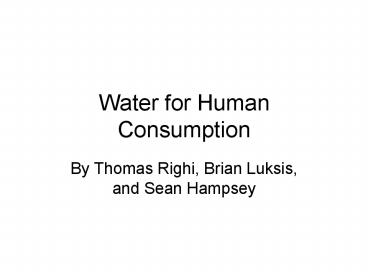Water for Human Consumption - PowerPoint PPT Presentation
1 / 11
Title:
Water for Human Consumption
Description:
... personal and domestic use' -United Nations Committee on Economics, Social, and ... salary would buy the sufficient amount of water a family needs in one day ... – PowerPoint PPT presentation
Number of Views:230
Avg rating:3.0/5.0
Title: Water for Human Consumption
1
Water for Human Consumption
- By Thomas Righi, Brian Luksis, and Sean Hampsey
2
Human Right to Water
- Entitles everyone to sufficient, safe,
acceptable, and affordable for personal and
domestic use -United Nations Committee on
Economics, Social, and Cultural Rights (MDGs) - 1.1 billion people are denied access to
sufficient clean water to meet basic needs. - Many of these countries face large inequities of
water availability. - Access to water in many poor countries is
widespread but in the poorest communities, water
is unreliable, not of good quality and often very
expensive.
3
Multiple Providers
- Water networks in most water deprived water
countries are usually operated by a single
citywide utility also with a range of
intermediaries between water and house hold - Water in the poorest countries is often provided
by multiple sources. While the rich may have
plentiful clean water, water in the slums is
usually provided by sand pipes, privately own
trucking services, and even sometimes from
neighbors and community wells. - Water sold through these intermediaries climbs a
price ladder, that in turn forces water to be
expensive in the areas that most need it most.
10 to 20 times more! - In Kenya a six month salary would buy the
sufficient amount of water a family needs in one
day
4
How to Solve this Problem
- A block tariff system is where prices rise on a
biases on how much is used to promote public
policy goals. Ex. A low or zero tariff can
enhance affordability. - In south Africa 25 liters a day is provided free
of charge to every citizen. - Poor is last in line because of three reasons.
Local scarcity, Communities providers, and
Politics.
5
Public Providers key to provision and financing
- The challenge for all providers, public and
private, is to extend access and overcome the
price disadvantage faced by poor households. - The source of weakness of public providers comes
through poor governance and the infrastructure
decay caused by underinvestment are recurrent
themes. - Public policy meets four key conditions guard
against political interference in the allocation
of resources, transparent policymaking to support
accountability, separation of the regulator and
the service provider, and adequate public
financing for the expansion of the network.
6
Private Providers
- The number of people served by private water
companies has grown from about 51 million in 1990
to nearly 300 million in 2002. - Concessions have been widely tried and tested,
with mixed results. - In the 1990s concessions were the main conduit
for private investment in water
7
Private Providers Cont..
- Three common failures, linked to regulation,
financial sustainability and transparency in
contracting, can be traced to these constraints - Network expansion, Tariff renegotiation, and
financing. - Another form of private sector involvement is
management contracts, which represents
arrangements in which a municipality or local
government purchases management services.
8
Delivering the Outcomes
- Two words summarize the starting point for
accelerated progress in water, National
Strategy. Here are four ways to start - 1. Establish clear goals and benchmarks for
measuring progress. - 2. Ensure polices in water sector are backed by
secure financing provisions in annual budgets. - 3. Develop clear strategies for overcoming
structural inequalities based on wealth, location
and others. - 4. Create a governance system that will make
governments and water providers accountable for
their goals.
9
Public access and Financing for the Poor
- Solving Cost recovery through tariffs must be
limited to include the how the poor households
will gather enough to pay. - This creates a central role for public spending
in extension to water in poor households - Also highlights importance of cross-subsidies in
utility pricing
10
Mixed Results
- Subsidies through water tariffs vary to different
poor. - With low connection rates, and most that lack
connection are poor, progressive outcome is
unlikely. - But Chile, for example, receive subsidies on
water and compensates the utility through
government payments.
11
A Call for Regulation
- Regulation is KEY
- With limited competition for funding, regular
authorities need to ensure that providers are
managed correctly. - Some key areas are Political independence, the
ability to investigate and show penalty power,
being able to share to the public the pricing and
other water facts, and finally Public
Participation to ensure the consumers interests
are represented.































